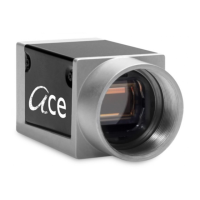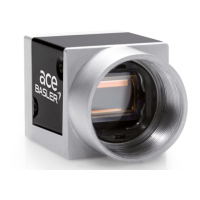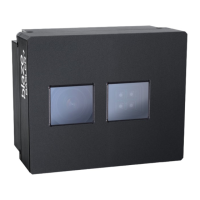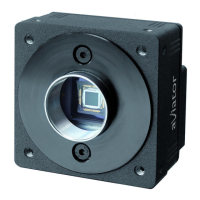Features AW00123409000
258 Basler ace USB 3.0
7.10 Scaling
For information about the availability of the scaling feature on a specific camera model, see
Table 41 on page 191 and Table 42 on page 192.
The scaling feature allows you to shrink the size of a frame and to expand a shrunk frame up to its
original size. Thereby, pixel values are added and averaged as required to map them from one
(current) frame to the virtual pixels of the other frame. The scaling feature does not allow to expand
a shrunk frame beyond its original size.
When using the scaling feature, a factor is applied to the width of the current frame (horizontal
scaling). A factor of 1.0 causes no change to the original size of a frame. A factor less than 1.0
causes the width of the frame to shrink.
When horizontal scaling is applied, the scaling feature automatically applies the same factor to the
height of the frame (vertical scaling). Thereby, the aspect ratio of the original frame is preserved.
By applying a factor that is greater than the previous one but still below 1.0, you can expand the
size of the shrunk frame up to its original size (factor 1.0).
The factors available for scaling obey the following:
ORW: original ROI width [pixels]
SRW: scaled ROI width [pixels]
DSC = 16/x; where x is any natural number ranging from 16 to 128.
Accordingly, the scaling factors (DSC) range from 1.0 (no shrinking) to 0.125 (most extreme
shrinking).
The scaled ROI width calculates as:
SRW [pixels] = (ORW × DSC) - 2
When scaling is used, binning and decimation are not available.
For more information about binning, see Section 7.8 on page 245.
For more information about decimation, see Section 7.9 on page 253.

